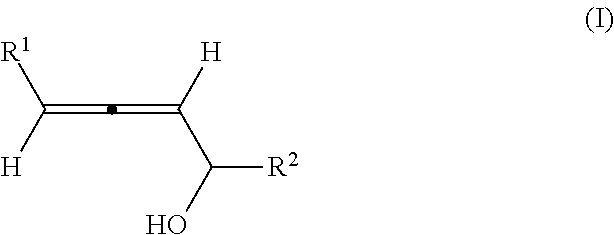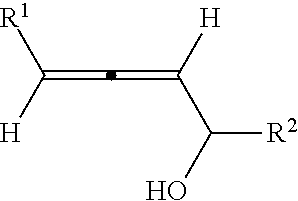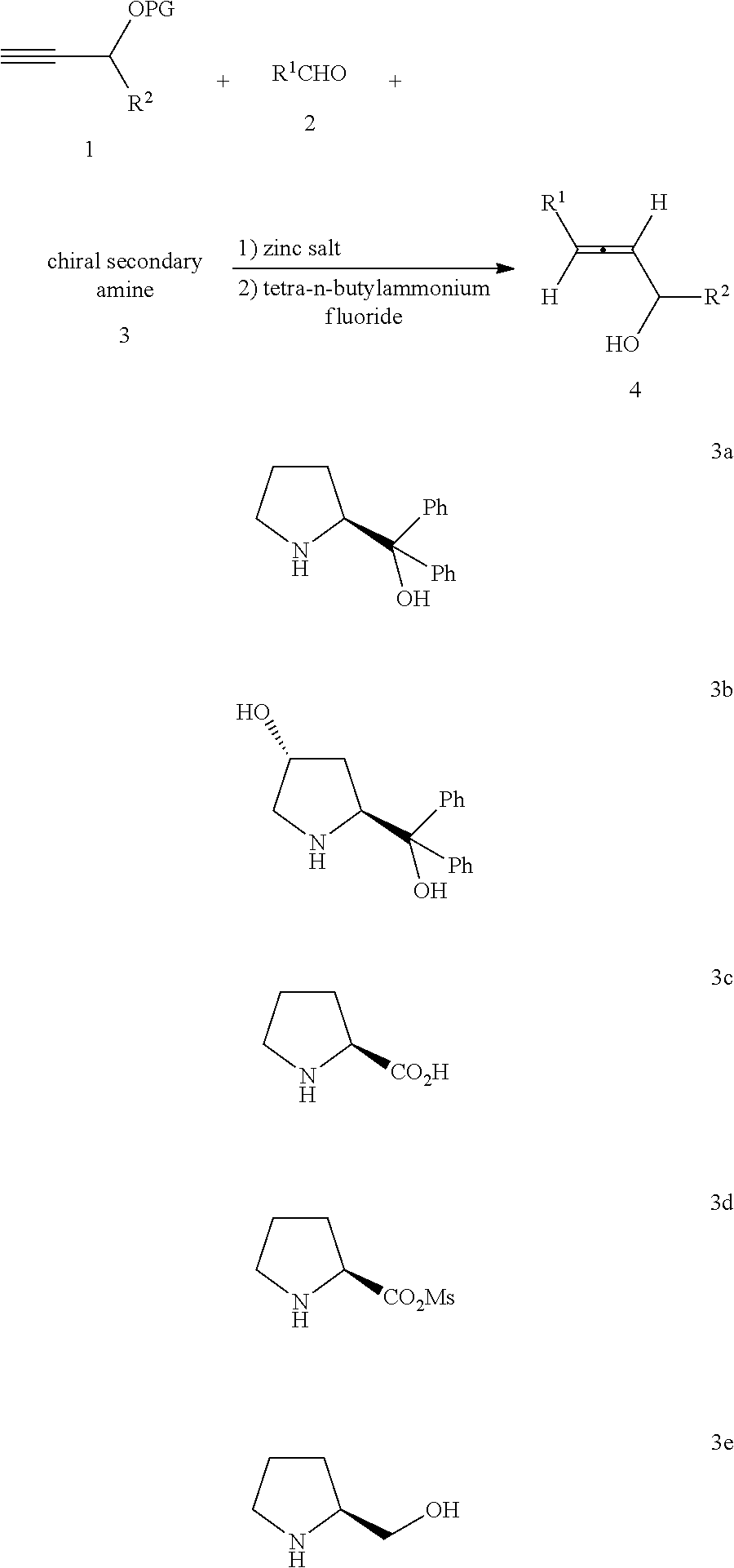Optically active axially chiral alpha-allenic alcohol, synthesis method and use thereof
a technology of optically active axially chiral alpha-allenic alcohol, which is applied in the preparation of oxygen-containing compounds, organic chemistry, chemistry apparatus and processes, etc., can solve the problems of inconvenient operation, low total yield, and unsuitability for large-scale synthesizing, and achieves the effect of effectively preparing axially chiral -allenic alcohol and synthesizing conveniently
- Summary
- Abstract
- Description
- Claims
- Application Information
AI Technical Summary
Benefits of technology
Problems solved by technology
Method used
Image
Examples
example 1
[0016]
[0017]wherein “equiv” represents equivalent, “mol” represents mole, “TBS” represents tert-butyldimethylsilyl, “Cy” represents cyclohexyl, “TBAF” represents tetrabutylammonium fluoride, “TIF” represents tetrahydrofuran, “rt” refers to room temperature, “e” represents enantiomeric excess, and “de” represents diastereomeric excess.
[0018]Under the protection of an inert gas, ZnBr2 (169.3 mg, 0.75 mmol) was added to a dried reaction tube, dried with heating gun. Then α,α-diphenylprolinol (S)-3a (258.7 mg, 1.0 mmol, 98%), propargyl alcohol protected by tert-butyldimethylsilyl group 1a (188.2 mg, 1.1 mmol), dehydrated toluene (2 mL), newly distilled cyclohexanecarboxaldehyde 2a (168.6 mg, 1.5 mmol), and dehydrated toluene (1 mL) were added. The reaction tube was then equipped with a reflux condensing tube, and placed into an oil bath that had been previously heated to 130° C. and stirred under reflux for 10 hours. After cooled to the room temperature, the product was filtered with a ...
example 2
[0019]
[0020]Operations were conducted by referring to Example 1: Using ZnBr2 (1.6912 g, 7.5 mmol), α,α-diphenylprolinol(S)-3a (2.5857 g, 10 mmol), propargyl alcohol protected by tert-butyldimethylsilyl group 1a (1.8738 g, 11 mmol), newly distilled cyclohexanecarboxaldehyde 2a (1.6831 g, 15 mmol), dehydrated toluene (30 mL), TBAF.3H2O (3.1563 g, 10 mmol) and tetrahydrofuran (30 mL), column chromatography (petroleum ether / ethyl acetate=15 / 1 (800 mL)→10:1) to afford a liquid: axially chiral α-allenic alcohol (R)-4aa (1.0624, 70%): 99% ee (HPLC measurement conditions: Chiralcel AS-H column, n-hexane / isopropanol=98 / 2, 0.6 mL / min, λ=214 nm, tR(large peak)=11.9 min, tR(small peak)=12.9 min); [α]22D=−100.3 (c=1.00, CHCl3); 1H NMR (300 MHz, CDCl3) δ=5.42-5.26 (m, 2H, CH═C═CH), 4.11 (s, 2H, OCH2), 2.07-1.94 (m, 1H, CH from Cy), 1.82-1.49 (m, 6H, OH and protons from Cy), 1.36-1.00 (m, 5H, protons from Cy).
example 3
[0021]
[0022]Operations were conducted by referring to Example 1: Using ZnBr2 (506.8 mg, 2.25 mmol), α,α-diphenylprolinol (S)-3a (775.4 mg, 3.0 mmol), propargyl alcohol protected by tert-butyldimethylsilyl group 1a (562.4 mg, 3.3 mmol), newly distilled iso-pentaldehyde 2b (388.1 mg, 4.5 mmol), dehydrated toluene (9 mL), TBAF.3H2O (947.3 mg, 3.0 mmol) and tetrahydrofuran (5 mL), column chromatography (petroleum ether / ethyl acetate=15 / 1) to afford a liquid: axially chiral α-allenic alcohol(R)-4ab (171.2 mg, 45%): 98% ee (HPLC measurement conditions: Chiralcel AD-H column, n-hexane / isopropanol=200 / 1, 1.0 mL / min, λ=214 nm, tR(large peak)=20.4 min, tR(small peak)=25.3 min); [α]22D=−80.3 (c=1.01, CHCl3); 1H NMR (300 MHz, CDCl3) δ=5.35-5.18 (m, 2H, CH═C═CH), 4.11 (s, 2H, OCH2), 2.03-1.79 (m, 3H, OH and CH2), 1.76-1.58 (m, 1H, CH), 0.92 (d, J=6.6 Hz, 6H, two CH3); 13C NMR (75 MHz, CDCl3) δ=203.6, 92.2, 90.9, 60.8, 38.1, 28.3, 22.1; MS (EI) m / z (%): 126 (M+, 0.21), 55 (100); IR (neat): v=3326...
PUM
| Property | Measurement | Unit |
|---|---|---|
| temperature | aaaaa | aaaaa |
| temperature | aaaaa | aaaaa |
| temperature | aaaaa | aaaaa |
Abstract
Description
Claims
Application Information
 Login to View More
Login to View More - R&D
- Intellectual Property
- Life Sciences
- Materials
- Tech Scout
- Unparalleled Data Quality
- Higher Quality Content
- 60% Fewer Hallucinations
Browse by: Latest US Patents, China's latest patents, Technical Efficacy Thesaurus, Application Domain, Technology Topic, Popular Technical Reports.
© 2025 PatSnap. All rights reserved.Legal|Privacy policy|Modern Slavery Act Transparency Statement|Sitemap|About US| Contact US: help@patsnap.com



